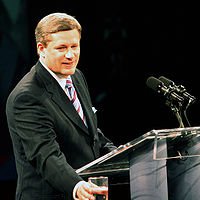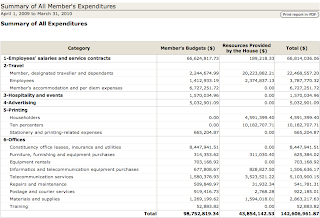
 Now that the Harper Government has passed the so-called "Fair Representation Act", let’s take a look at a few Parliamentary statistics:
Now that the Harper Government has passed the so-called "Fair Representation Act", let’s take a look at a few Parliamentary statistics:First, let’s take a look at Canada’s overall population and the level of representation compared to our neighbour to the south:
Canada’s population (2011 Statscan projection): 34,532,000
Number of Members of Parliament: 308
Population base per Member of Parliament: 112,120
Number of Senators: 105
Population base per Senator: 322,800
United States’ population: 308,745,538
Number of Members in the House of Representatives: 435
Population base per Member of the House: 709,760
Number of Senators: 100
Population base per Senator: 3,087,455
First, I do realize that the two systems of governance are entirely different, however, as we can quickly see, Canada has far more representation at both levels of government than the United States. In fact, the number of Members of the House of Representatives has not changed since 1911 when the population of the United States was only 91,972,266. Even though the American population has more than tripled over the last century, the number of Representatives has remained constant with a brief increase to 437 in the years between 1959 and 1963 when the States of Alaska and Hawaii were added.
On a Canada-wide basis, each Member of Parliament represents an average of only 112,120 people. In actuality, based on the 2006 Census, the number of constituents that an MP represents ranges from a high of 124,572 in the West Vancouver-Sunshine Coast-Sea-to-Sky riding to a low of 32,245 in the Charlottetown, PEI riding. Prince Edward Island is by far the most over-represented province with four MPs representing an average of only 33,824 residents each in 2006. Please note that I have excluded Labrador, Nunavut and the Yukon since they have huge areal expanses with very low population densities compared to other ridings. Looking back at the statistics for the United States, on average, a Canadian MP represents 15.8% (less than one-sixth) of the number of people that an American Member of the House represents and a Canadian Senator represents 10.5% (just over one-tenth) of the number of people that an American Senator represents.
Since each MP gets a base salary of $157,731 annually, an additional 30 MPs will cost Canadian taxpayers an additional $4.73 million each year in salaries alone ad infinitum or at least until the House adds even more or salaries and expenses rise. Each MP gets the same base salary whether they are "stars" sitting near the front row in the House of Commons or the dim bulbs vegetating in the back rows, playing with their Blackberrys rather than paying attention to the matters of governing Canada. Salaries are a small part of the total compensation package; expense allowances, 64 annual return plane tickets, staff and office expenses, committee fees etcetera for each of the 30 new MPs will cost the Canadian taxpayer far more than the base salary expense.
Let’s look at how much Canadians paid for their MP’s other expenses from April 1, 2009 to March 31, 2010:
If we split the $142,606,961.87 evenly across the 308 MPs, each of our elected representatives spent $463,010 on average to travel, employ staff, dine, print ten percenters, lease office space etcetera. If we were to add 30 more MPs, Canadian taxpayers would be on the hook for an additional $13,890,000 in expenses alone and, once again, that’s a forever expense. When the MP expense amount is added to the salary amount, Canadians will be shelling out an additional minimum of $18.6 million annually to be "better represented" in Ottawa. While I realize that $20 million is chump change compared to what our MPs are used to spending, as Canadian taxpayers, we earn all $20 million of those dollars one at a time.
Rather than adding additional Members of Parliament, I would suggest that changes to riding boundaries would have better balanced population distribution in each riding. For example, Prince Edward Island should have two MPs (and, for that matter, Senators) at most. Manitoba, Saskatchewan, Nova Scotia, New Brunswick and Newfoundland and Labrador are over-represented to a lesser degree and could easily have the ranks of their MP thinned and redistributed to the larger existing ridings. The same could be said for the rural ridings adjacent to the urban centres that have experienced rapid population growth.
Increasing the number of Canada’s MPs will have no marked effect on the level of representation for the average Canadian. Ask yourself how often you actually see and interact with your MP in person. Does your MP even show up at your door during an election campaign and does he or she respond to your telephone calls, emails or letters in anything but a cursory manner? I suggest that it won’t matter whether Canada’s MPs represent 35,000 or 350,000 constituents; you will interact with them no more and no less with them than you do now. Your riding will be no better represented in the House if there are more MPs whiling away the hours in Ottawa.
In these times of huge budget deficits and growing national debt, more government is not necessarily better government. Our existing MPs just need to learn how to be more efficient workers for the people who vote them into office. That’s a hard lesson that we’ve all had to learn.
Click HERE to read more of Glen Asher’s columns.
Article viewed on Oye! Times at www.oyetimes.com
You can publish this article on your website as long as you provide a link back to this page.


Be the first to comment